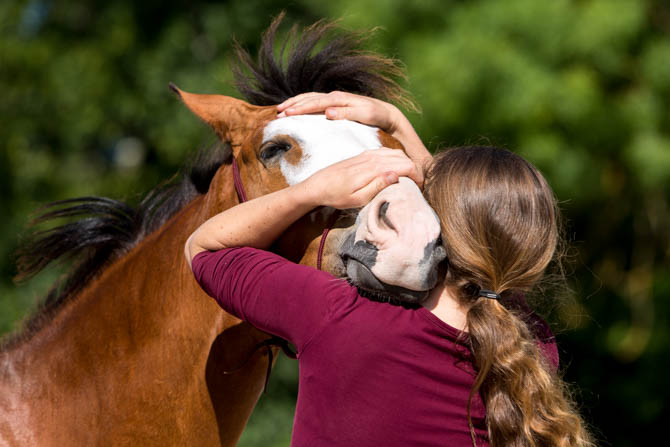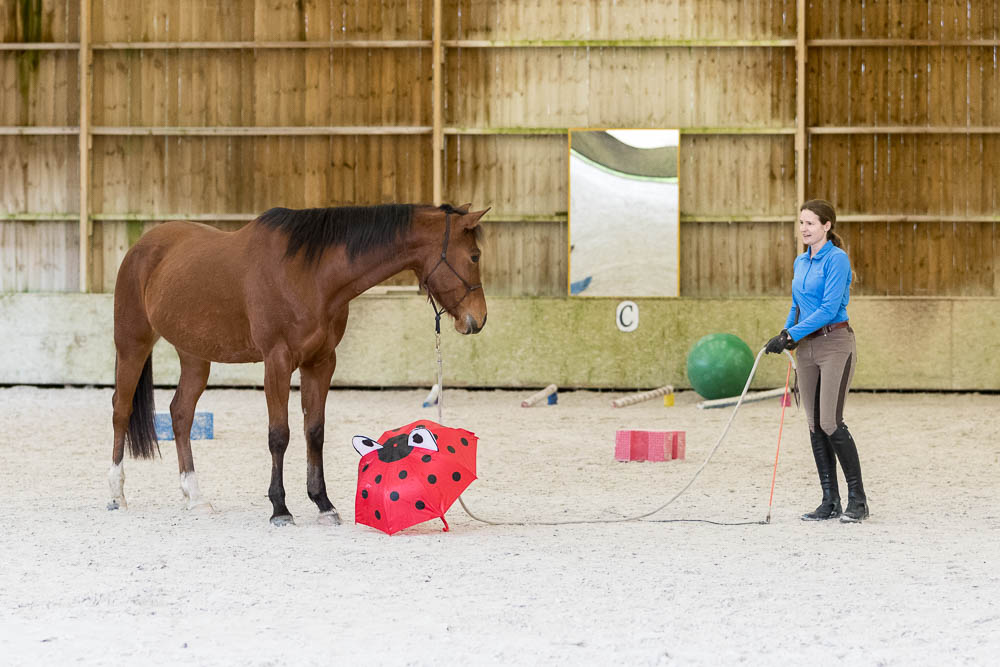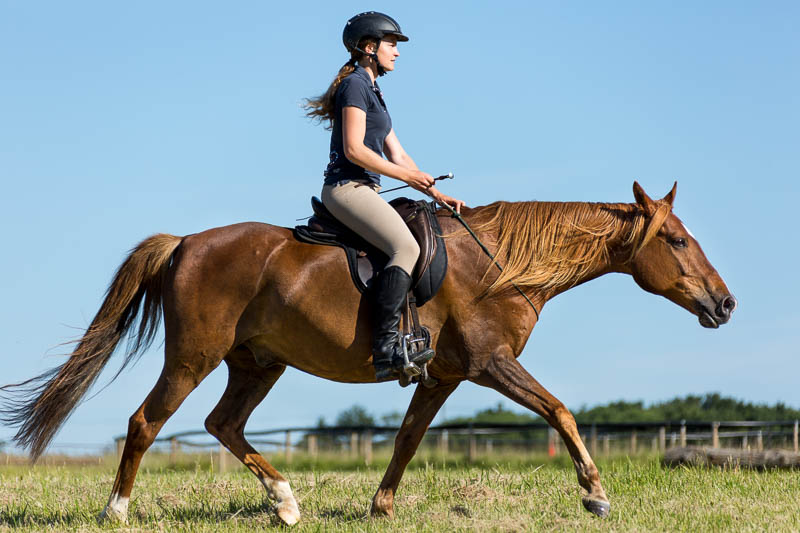Preparations for Colt Starting: Get ready to accept the rider with confidence [Video]

This is the fifth and last article with a detailed explanation of the “14 Preparations for a safe and respectful Colt Starting”.
To understand the whole concept behind it I recommend to read “14 Preparations for a safe and respectful Colt Starting” first.
Accepting the rider on the back is all about confidence
What if your horse was so confident, that he accepts you as a rider without any worry or fear? When we ask a horse to accept to carry us on his back, it is a question of total confidence and trust.
Being a prey-animal, the rider might very well be perceived as an attacking wolf. It is the same positions, almost in a blind spot and our legs are wrapped around the horse’s body touching the sensitive flanks.
With some specific exercises, you can boost your horse's confidence in you as his leader and in himself. Discover how you can prepare your horse to confidently accept you on his back.
In this article I will explain 3 confidence building exercises to you:
Exercise #12: Ball on the Back: boost the horse’s confidence with objects above him
Exercise #13: Accept the plastic flag: boost the horse’s confidence with sudden movements
All three exercises are confidence building and some people might call them desensitization. I don’t like to use that word. I rather say that they will help the horse’s confidence in his own ability to deal with scary things.
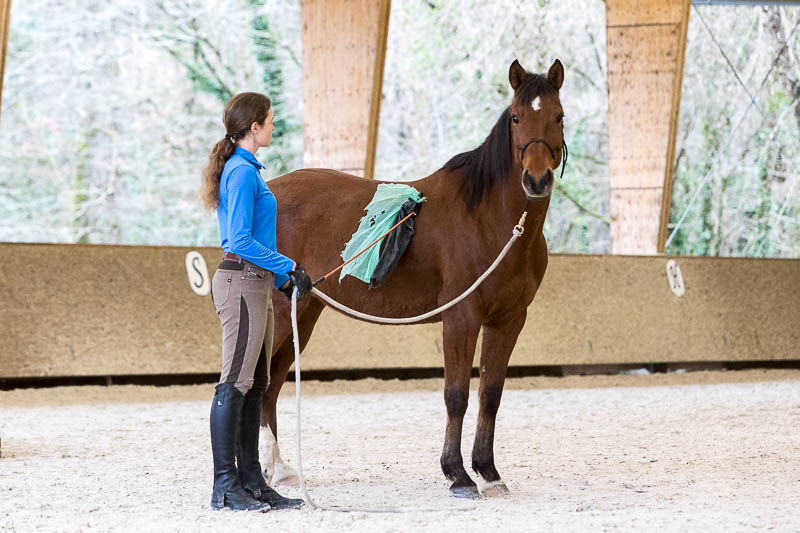
Follow these 4 Tips to success with all 3 Exercises:
1. Rythme
Be rhythmic in all your movements. This will help the horse to anticipate what is coming and he will be able to relax sooner. Be rhythmic in your sequences and repetitions.
Horses are rhythmic animals. As we humans are predators by nature, we tend to sneak and attack. We approach slow and then do a sudden movement.
Don’t try to not spook the horse by sneaking closer and closer to the scary object. Use nonchalant rhythm instead.
2. Approach - Retreat
The approach provides the stimulus you want to get your horse used to, retreat creates curiosity and confidence.
The approach doesn’t only mean to come closer in a physical way, but also:
- to increase intensity
- to increase frequency
- to increase the height of the bounce
- to come close to a part of the body the horse is more protective about
Retreat doesn’t only mean to quit doing something, it also means to:
- decrease intensity
- decrease frequency
- bounce lower
- move away from the horse
- make less noise
- move away from the body part the horse is more protective about
You want to rhythmically change between approach and retreat to build your horses confidence.
Retreat when your horse shows signs of worry and re-approach when your horse shows signs of increasing confidence.
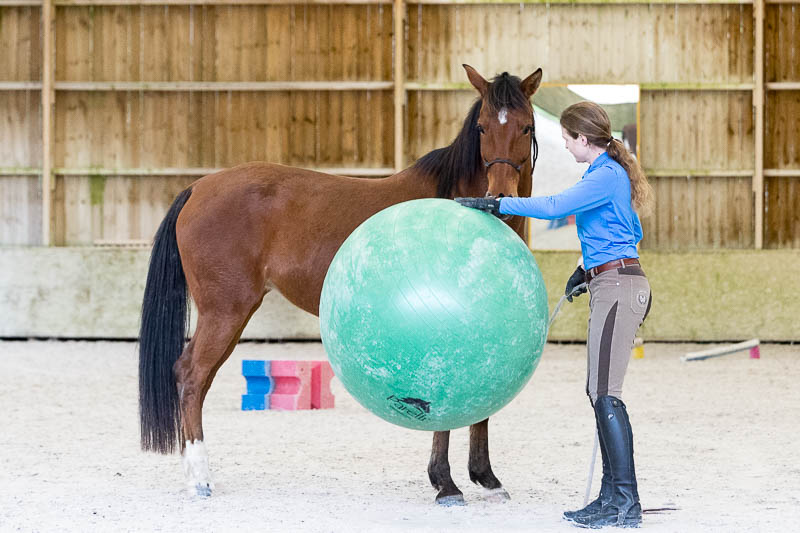
3. Relaxation
Relaxation is key - only quit when your horse shows signs of relaxation. Can you identify those signs?
A horse which doesn’t move isn’t necessarily relaxed - it might be very tensed and frozen. Signs of true relaxation are:
- looking at the stimulus
- blinking the eyes
- releasing tension in the neck
- sigh
- lick and chew
Observe your horses eye: Where does he look? Is he still blinking? A horse that is not blinking, is scared and ready to take off.
Reward when your horse looks at the stimulus at first - you teach your horse to confront himself with scary things.
The very last sign is usually that the horse licks and chews. If you get to this point, your horse most probably has decided that whatever you did before, is alright.
4. When to release
Don’t quit when your horse moves or reacts scared! Only decrease the intensity a bit (retreat) and move away from the horse.
Only release and quit when your horse gives you one of the 5 signs mentioned above. Otherwise, you will teach your horse that acting on his flight instinct is the solution.
The purpose of these confidence games is to teach your horse that relaxation and trust are the solutions.
Exercise #12 Ball on the Back
This exercise will increase the horses level of confidence about objects and movements on top of his body. If a young horse can accept a ball with confidence on his back, it will most probably also accept the rider with ease.
Objective
The horse is confidently standing still and is relaxed while I bounce the ball next to him and lift it on his back
Benefits
- Simulates the hopping before mounting
- Confidence with objects above
Material needed
Gymnastic ball of at least 75 cm in diameter
How to help your horse to be confident having the Ball on his Back
Start with rolling the ball away from your horse and encourage your horse to follow it. This will make the horse curious and eventually he will touch it with his nose and maybe start to explore it.
Then bounce it in away from your horse. Encourage your horse to follow and quit once your horse looks at it and wants to touch it.
Now bounce it without moving away from your horse in front of him. When he can accept that, bounce it next to his neck.
Always retreat to the step before when your horse gets worried. Proceed until you can bounce the ball next to your horses' side without that he moves away.
Once you can do that, proceed in these steps:
- bounce low - high - low - high - low
- bounce low - high - hold it up
- bounce low - high - hold it up - touch short
- bounce - bounce - hold - touch long
- bounce - bounce - touch - roll it on the back
Celebrate!
What if your horse is really afraid?
Watch this Video how I helped my mare Salima to get confident to accept the ball on her back.
This is real-time footage of the very first time I ever attempted to that with her! Initially, she was extremely afraid of the ball, even it`s presence in the arena scared her at first.
At the time when I did this exercise with her, she had already learnt that she can push the ball away from her.
Exercise #13 Accept the flag
This exercise will help the horse to become more confident with sudden noises and movements.
Some young horses react very sensitive to movements they can see only in the corner of their eye or on top of them—for example, the rider’s hands or legs.
Or just imagine you are wearing a noisy rain jacket for the first time on your colt. Getting a horse to accept the plastic flag flapping around and on his body with confidence will ultimately increase his total level of confidence.
Objective
The horse can confidently stand still and is relaxed while you rub his body with a plastic flag and shake above his back
Benefits
- increases confidence in you as a leader
- the horse learns how to deal with sudden noises and movements
- good preparation for the day you wear your rain jacket
Material needed
Stick with a noisy plastic bag
How to
Watch the Video to see how I help my mare Salima to get confident with the plastic flag. This is real-time footage and truly the first time I confronted her with the plastic flag.
What to do if your horse is really scared:
Many horses react a lot more scared than my Salima to the flag. If your horse is very scared, slow everything down.
Don’t skip a step, read your horse well to see the little signs of improvement. This will help you to know when to retreat and when you can re-approach and when you can quit completely.
Look out for these signs to know when to retreat (not release and quit)
- eyes wide open
- tight and twitching muscles
- tight mouth
- ears not moving
- head high
- one hind leg cocked
- running crazy
Change between approach and retreat until you see one of these signs:
- look at the stimulus
- eyes blinking
- neck relaxes
- sighs
- lick and chew
- standing still
Read the story of Aslan, a pony who was extremely scared of a lot of things. This is an extreme example, but I am sure it will give you some inspiration.
Exercise #14 The Hugging Station
Every rider knows the problem when the horse is not standing still for mounting. With this exercise, your horse will not only learn to position himself, but it will fall in love with the mounting block.
You let it become a place of comfort and rest. It doesn’t take much time and patience to get this done at all.
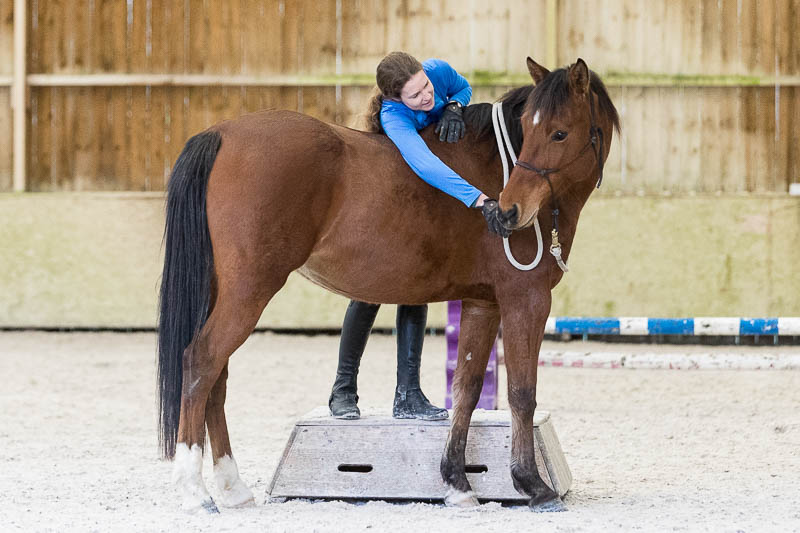
Objective
Your horse learns to position himself at the mounting block and falls in love with this place. He is confident with you in a higher position and leaning over his back - hug your horse!
Benefits
- teach your horse to stand still at the mounting block
- your horse will love the mounting block
- later your horse will come to pick you up for a ride
Material needed
Something at least 50 cm high and solid to use as a mounting block
How to
I like to do this exercise several times in one session, each time for just some short minutes. Usually, I do it after something dynamic and when the horse is connected.
When you do this exercises, have a very relaxed, patient and loving attitude. Usually, by the third time of doing this, your horse will position himself!
Slow everything down. Your molecules inside, your thoughts, your energy. The more you try to MAKE this exercise happen, the longer it will take. To me, this exercise is like meditation.
I enter into a very private bubble with my horse. I close everything else out - it is just the two of us. No pressure. I wait for the horse to be ready and open for this. This is the very start of something great.
Lead your horse to your mounting block and step on it. Very slowly lead your horse step by step closer to you while you hold your other arm over your horse’s withers - like an inviting hug.
Once your horse is in a good position, hug your horse. Gently rub his neck, withers, shoulders and back. Talk to your horse and relax, enjoy.
Some horses are not confident to see the human so high and behind their withers. If this is the case, be patient.
Maybe your horse can accept you at his shoulder - this is already great. Soon he will accept you where the saddle will be one day.
Be patient and progressive. Remember, you are building a very important piece of the puzzle here. You start to ask for permission from your horse to accept to carry you on his back!
Conclusion:
With these 3 exercises, you have laid a good and solid foundation of confidence in your horse. Your horse is well prepared to deal with sudden movements, big, bouncy objects and he fell in love with the mounting block.
The next step in the journey of your horse would be to accept you as a rider on his back. To do this step with ease and to make it an enjoyable first ride for the horse, it does take some skill.
You need to be able to read your horse’s expressions very well and spot on.
Don’t do this without guidance if you are not experienced!
Related Articles
